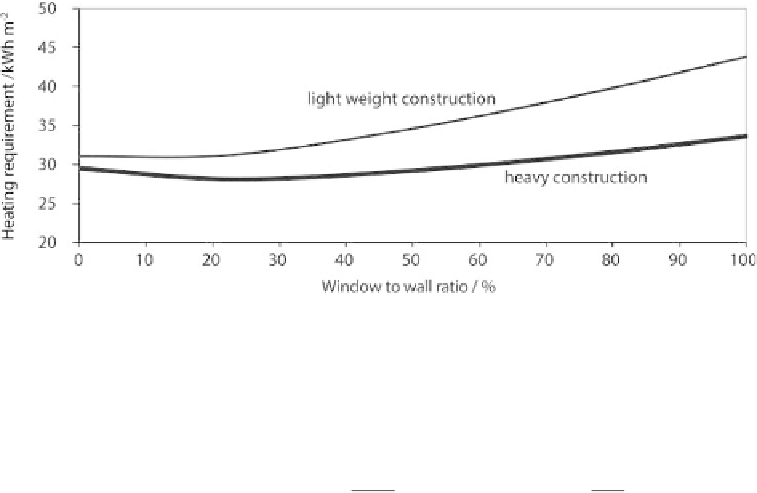Environmental Engineering Reference
In-Depth Information
Figure 18.3.3
Influence of the window area proportion on the heating requirement.
energy per square metre of glazing surface for two-pane low-e coated glazing with a
U
w
value of 1 W m
−
2
K
−
1
and
g
=
0.65 is:
Q
u
A
w
=
10
3
Wh
1
.
0
W
3500
K days
a
h
day
0
.
65
×
400
×
m
2
a
−
m
2
K
×
×
24
(18.3.11)
260
kWh
m
2
84
kWh
m
2
176
kWh
m
2
=
−
=
The amount of heat effectively usable in the room depends greatly on the storage
capability of the structural elements inside. High passive solar heat gains can easily
lead to overheating of the interior and thus do not contribute to covering the heating
requirement.
According to the EN 832 monthly balance procedure for calculating the heating
requirement, the efficiency of the solar irradiance transmitted by windows is a function
of the relation of the monthly gains to the transmission and ventilation heat losses.
For lowenergy buildings with heat-storing heavy building construction and an annual
heating requirement of between about 30 and 70 kWh m
−
2
a
−
1
, the result is a flat
minimum of the heating requirement for a window area proportion on the south-
facing façade of approximately 25%. In administrative buildings with mostly higher
internal loads, the window area proportion should be even lower to avoid overheating
in summer; this is described in Figure 18.3.3. The minimum heating requirement is
obtained for 0-20% of the window area proportion for a light building with a small
storage capacity and between 20 to 30% for a building with high internal mass.
18.4 NEW GLAZING SYSTEMS
For flexible control of total energy transmission, glazing systems are being devel-
oped that modify their transparency degree temperature-dependently (thermo-tropic)
or electrically controlled (electro-chromic).

Search WWH ::

Custom Search